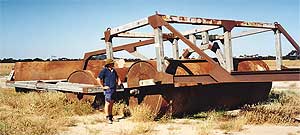South Perth, Western Australia
July 18, 2005
The Department of
Agriculture, Western Australia has kicked off its campaign
to guide new field pea growers on the back of a massive
expansion in field pea plantings this season.
Pulse agronomist Mark Seymour said many
Western Australian
growers had invested in the crop for the first time and were
looking to get the best results from field peas.
 |
|
Researcher Mark Seymour looks at one of the State’s
biggest steel rollers, suited to paddocks with limestone
rock. |
Mr Seymour said rolling was a vital step to
flatten and clean field pea paddocks to ensure an efficient
harvest.
“Most field peas are sown with knife points and
press wheels and this leaves the paddock with well defined
ridges,” he said.
“All field peas will lodge at harvest, and it is
best to harvest across the lay of the lodged plants. This is
virtually impossible if the paddock still has noticeable seeding
ridges.”
“It is possible to flatten the ridges with
harrows at seeding, but this may not be adequate on many soils,
and it does not push in sticks and stones. For a better result,
all field pea paddocks should be rolled with either a
rubber-tyred or steel roller,” he said.
Rolling can occur either before plants have
emerged (directly after seeding) or once the plants reach the
three node stage through to the 10-12 node stage.
“Rolling immediately after seeding improves the
safety of most soil-applied herbicides and allows growers to
apply post emergent herbicides when required without waiting for
the crop to recover from being rolled,” Mr Seymour said.
“Rolling between emergence and the three node
stage is not recommended as the plants are small and prone to
damage. Growers should roll plants in the afternoon when they
are more flexible and avoid rolling early in the morning or on
very cold days.”
Mr Seymour said there was no difference between
the impact of rolling trailing types like Dundale and Parafield
and the semi-leafless lines of Kaspa and Snowpeak, although the
semi-leafless lines seemed to be stiffer plants later in the
season.
The Department is currently conducting a trial at
Katanning to determine the effect of rolling Kaspa at various
stages – from emergence to just before flowering. |